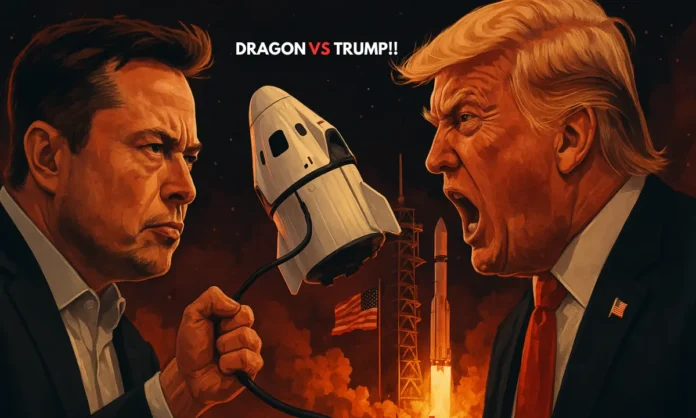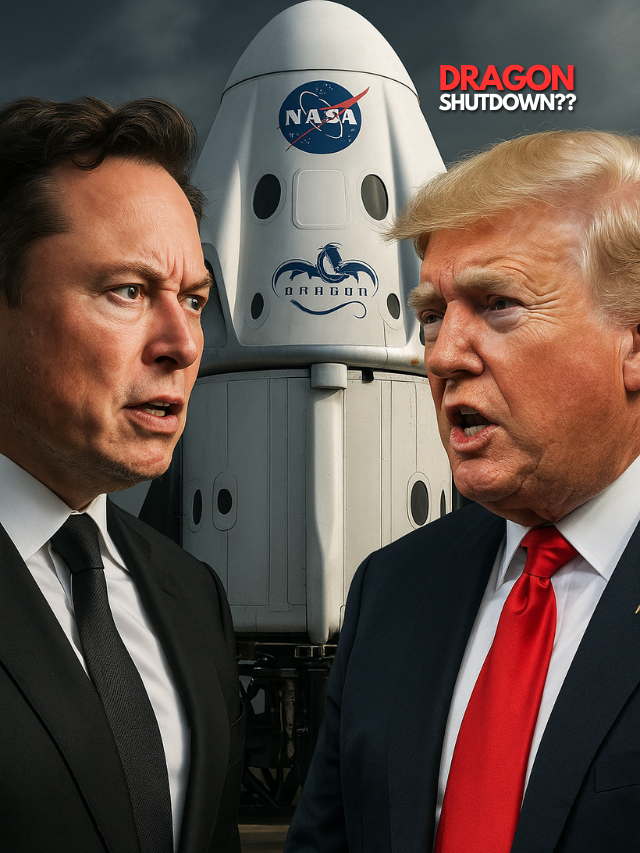SUMMARY
- Elon Musk vows to “decommission” the Dragon spacecraft amid a high-voltage standoff with President Trump.
- NASA’s manned missions, Artemis moon plans, and $22 billion in U.S. contracts now hang in the balance.
- Experts warn of a historic grounding of American spaceflight and national security disruption.
When Billionaires Collide with Orbits: The Space Crisis No One Saw Coming
In a moment that feels ripped from the pages of speculative fiction, a real-world power struggle now threatens to shake the foundations of American spaceflight. Elon Musk, whose SpaceX Dragon spacecraft has become NASA’s primary vehicle for ferrying astronauts to and from the International Space Station, has declared he is ready to pull the plug. The move, sparked by a furious fallout with U.S. President Donald Trump, risks unraveling not just scientific exploration, but also the national security and geopolitical leverage tethered to space.
The clash escalated after Trump floated terminating federal contracts linked to Musk’s firms, citing disagreements over tax disclosures and policy dissent. Musk responded with a nuclear option: shutting down Dragon. The implications go beyond billionaire bravado. The Dragon capsule, funded through a $5 billion NASA contract, is currently the only American crew vehicle in operation. Its decommissioning would halt new astronaut missions and force a return to reliance on Russia’s aging Soyuz system—a move many experts see as a historic regression.
While NASA maintains diplomatic neutrality, stating it will “work with industry partners,” space insiders are sounding alarms. With over $22 billion in government contracts at stake—including Artemis moon landings, Starlink military payloads, and ISS operations—the consequences are not only existential for NASA, but strategic for the United States’ future in space.
Escalation!!!
— JoeLange (@JoeLang51440671) June 5, 2025
Elon now threatens to cut off all Space X assistance and cooperation with NASA.
In case people have missed this.
NASA has been irrelevant for a decade and relegated to the dustbin of history.
The “private” sector has PROVEN that they can accomplish far more… pic.twitter.com/teYiXGBhJC
Dragon on the Edge: What NASA and the White House Now Face
- NASA’s only functioning astronaut transport system is threatened with termination.
- $22B worth of active government contracts with SpaceX are now in jeopardy.
- Boeing’s Starliner and other alternatives are either delayed, untested, or grounded.
NASA has been walking a strategic tightrope, relying almost exclusively on Elon Musk’s Dragon capsule to maintain a U.S. foothold in manned space missions. If SpaceX does indeed pull Dragon, the four astronauts currently aboard the ISS can return—but replacements will be stranded Earth-side. Boeing’s Starliner remains behind schedule, and other platforms like Sierra Nevada’s Dream Chaser or Northrop Grumman’s Cygnus are either cargo-only or not yet crew-certified.
More crucially, SpaceX isn’t just a cog in NASA’s machinery—it is the machinery. From Artemis III’s planned moon landing to classified Pentagon launches and the eventual deorbiting of the ISS, every component is SpaceX-linked. A sudden halt to operations doesn’t just pause missions—it dismantles timelines. Even NASA’s plan to decommission the ISS by 2030 depends on a SpaceX-built solution.
Financial markets have already responded with shock. Tesla shares plunged over 14% in a single day, wiping out $47.35 in value. But the broader loss—strategic momentum in space, national prestige, and public trust—might be harder to quantify.
From Moonshots to Meltdowns: The Bigger Fallout for American Space Ambitions
- Musk’s standoff threatens military comms, moon landings, and satellite launches.
- SpaceX rockets carry national security payloads and support U.S. orbital dominance.
- Critics warn of “rogue CEO behavior” endangering astronauts and taxpayer investments.
The geopolitical reach of SpaceX’s rockets extends far beyond the lunar dream. They carry critical military payloads, secure communications infrastructure, and surveillance tools that underpin U.S. space superiority. The Starlink constellation, increasingly vital to both defense and disaster zones, could also face unpredictable turbulence if the feud escalates.
Former NASA Deputy Administrator Lori Garver did not mince words: “A rogue CEO threatening to decommission spacecraft, putting astronauts’ lives at risk, is untenable.” The sentiment is shared by investors and national security experts alike, as Trump loyalists like Ted Cruz brace to defend legacy programs under threat.
Trump’s broader plan to revamp NASA through cost cuts, including a 25% reduction in its science division, already had critics. But this new development weaponizes spaceflight itself as a bargaining chip in political warfare. And with Musk now threatening to walk, the Trump-Musk rift is no longer just economic or ideological—it’s orbital.
Red Line in the Vacuum: Can the SpaceX–NASA Relationship Survive?
The showdown between Musk and Trump is no longer a sideshow—it is the main event in the future of U.S. spaceflight. If Musk decommissions the Dragon, it would represent an unprecedented act of private leverage against national infrastructure. At the same time, it exposes how deeply entwined U.S. space policy has become with a single man and his machine.
Whether this ends with compromise, litigation, or the literal grounding of the American space program remains to be seen. But one thing is clear: this moment will be studied not just by political analysts or aerospace engineers, but by historians tracking the rise—and potential unravelling—of 21st-century spacefaring ambition.



